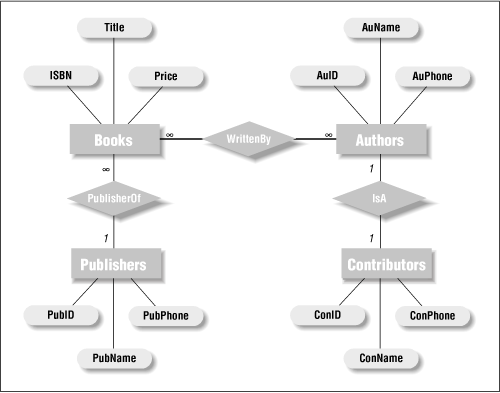Implementing the Relationships in a Relational Database
Now let us discuss how we might implement the relationships in an E/R database model. For convenience, we repeat the E/R diagram for the LIBRARY database in Figure 3.1.

Figure 3-1. The LIBRARY entity-relationship diagram
Implementing a One-to-Many Relationship—Foreign Keys
Implementing a one-to-many relationship, such as the PublisherOf relationship, is fairly easy. To illustrate, since {PubID} is a key for the Publishers entity class, we simply add this attribute to the Books entity class. Thus, the Books entity class becomes:
Books(ISBN,Title,PubID,Price)
The Books table scheme is now:
{ISBN,Title,PubID,Price}and the BOOKS table now appears as shown in Table 3.2 (sorted by PubID).
Table 3-2. The BOOKS Table Sorted by PubID
|
ISBN |
Title |
PubID |
Price |
|---|---|---|---|
|
0-12-333433-3 |
On Liberty |
1 |
$25.00 |
|
0-103-45678-9 |
Iliad |
1 |
$25.00 |
|
0-91-335678-7 |
Faerie Queene |
1 |
$15.00 |
|
0-99-999999-9 |
Emma |
1 |
$20.00 |
|
1-22-233700-0 |
Visual Basic |
1 |
$25.00 |
|
1-1111-1111-1 |
C++ |
1 |
$29.95 |
|
0-91-045678-5 |
Hamlet |
2 |
$20.00 |
|
0-555-55555-9 |
Macbeth |
2 |
$12.00 |
|
0-99-777777-7 |
King Lear |
2 |
$49.00 |
|
0-123-45678-0 |
Ulysses |
2 |
$34.00 |
|
0-12-345678-9 |
Jane Eyre |
3 |
$49.00 |
|
0-11-345678-9 |
Moby Dick |
3 |
$49.00 |
|
0-321-32132-1 |
Balloon |
3 |
$34.00 |
|
0-55-123456-9 |
Main Street |
3 |
$22.95 |
The PubID attribute in the Books entity class is referred to as a foreign key, because ...
Get Access Database Design and Programming, Second Edition now with the O’Reilly learning platform.
O’Reilly members experience books, live events, courses curated by job role, and more from O’Reilly and nearly 200 top publishers.

